Tour of P. Allen Smith’s Moss Mountain Farm: Terrace Garden and Sister Oak
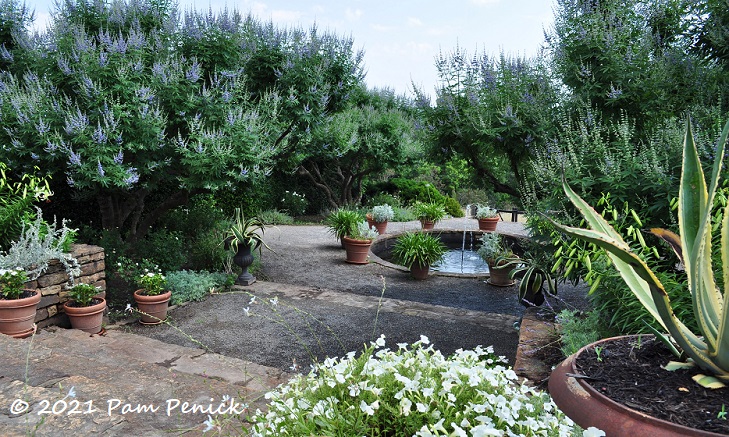
After St. Louis, Mom and I headed back to Texas via Little Rock, Arkansas. On the morning of June 17th, we wound our way into the hills northwest of the city and joined 80 others with a reservation for lunch and a tour of Moss Mountain Farm, the showplace home and gardens of TV personality, garden designer, and tastemaker P. Allen Smith — the South’s own Martha Stewart. Our tour group included avid P. Allen fans from all over the country and the merely curious or garden tourists, like ourselves.
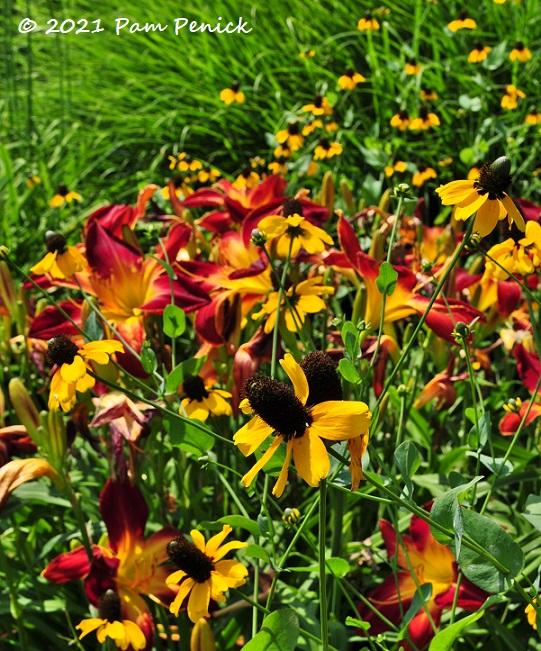
I haven’t seen Smith’s TV shows or read his books, but even so I know who he is. I bet every gardener in the South does. Allen, as his staff refers to him (the P. is for Paul), is a golden-haired gentleman farmer with a honeyed Southern drawl who’s created a media empire not in New York or California but smack-dab in the middle of Arkansas (where he has negotiated controversial big contracts for state dollars to promote Arkansas tourism).
About 10 years ago, Smith was annually handing out golden tickets like Willy Wonka to woo bloggers across the U.S. to come stay for a weekend at his farm, resulting in a flurry of publicity for his ventures. Not being one of the lucky recipients, I did wonder what all the fuss was about. Well, after springing for two tour tickets (at nearly $100 per ticket for up to 80 guests at a time, on approximately 40 dates per year, tours are a pretty sweet side gig for Smith), I finally found out.
Big Sister Oak and Garden Home
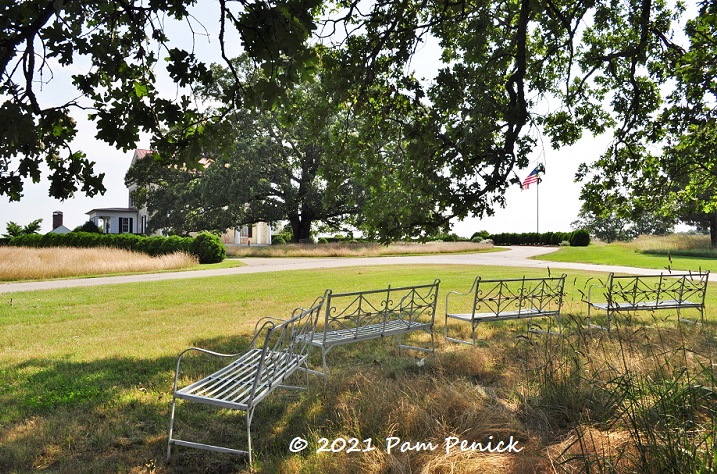
What I found is that Moss Mountain Farm, a 650-acre estate with a house overlooking the Arkansas River and classically designed gardens, is a beautiful and tour-worthy property, with a highly professional staff of guides and event planners. At its helm is P. Allen Smith himself, who, when he showed up at lunch for a casual talk, Q&A session, and book signing, proved to be gracious, charismatic, and tartly funny, with a talent for making his “guests” feel personally welcome.
But let’s back up and start with the garden tour. Mom and I arrived at 9:30 am for our 10 am tour, hatted and sunscreened, on a mid-June day that promised to be hot. Tour-goers milled around in the gift shop and under a big tent with lemon water and scones. Mom and I sat in the shade of a broad post oak, where a semicircle of white benches overlooked Smith’s Greek Revival home and another enormous post oak dubbed the Big Sister Oak.
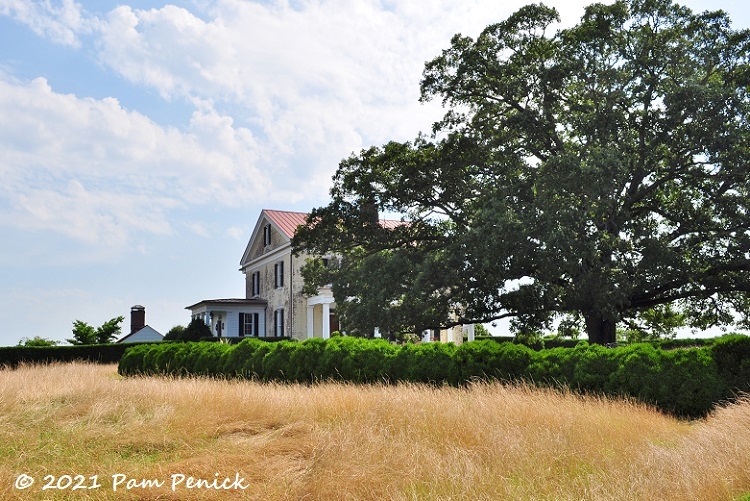
More than 300 years old, the Big Sister Oak stands squarely in front of the new-but-made-to-look-old house, spreading her limbs as wide as she is tall. The painted brick house defers to the tree, giving it star billing as you approach. Surrounding the inner hedged yard, turf grass is allowed to grow long and go to seed in summer.
If I remember right, Smith said it was zoysia grass, and his rule is no mowing after May in order to provide bird and other wildlife habitat and to let the grass seed out. I heard someone ask about snakes — in my experience, snakes are the number-one concern about tall grass — and our guide shrugged and said, “Yes, sure, we have snakes. They’re part of a healthy ecosystem.” No-mow and wildlife friendly? I was quickly becoming a fan.
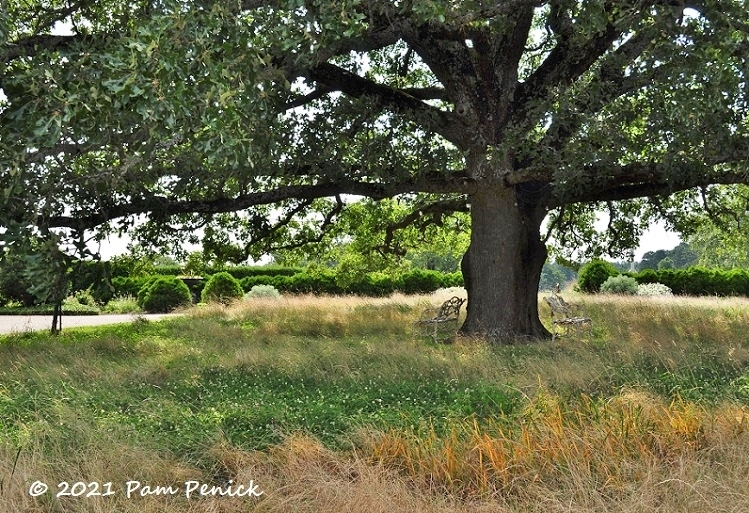
There’s a romance to this grand Sister Oak and the ungroomed meadow grasses under her leafy skirts. Twin iron benches back up to her massive trunk, with a mown path to reach them. The tree provides the main axis point along which Smith built his home and laid out the gardens.
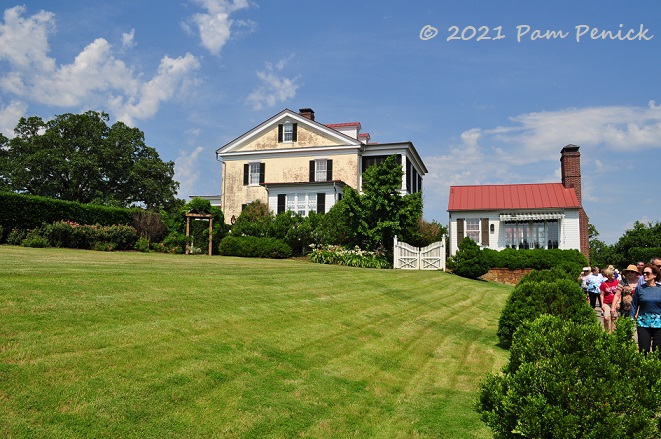
At the appointed hour, the guides welcomed us and divided our group of 80 into two groups (normally it’s 3 smaller groups, but they were short a guide), one starting with the house tour, the other with the Terrace Garden that runs along the slope behind the house.
Vitex pond and Arkansas River view
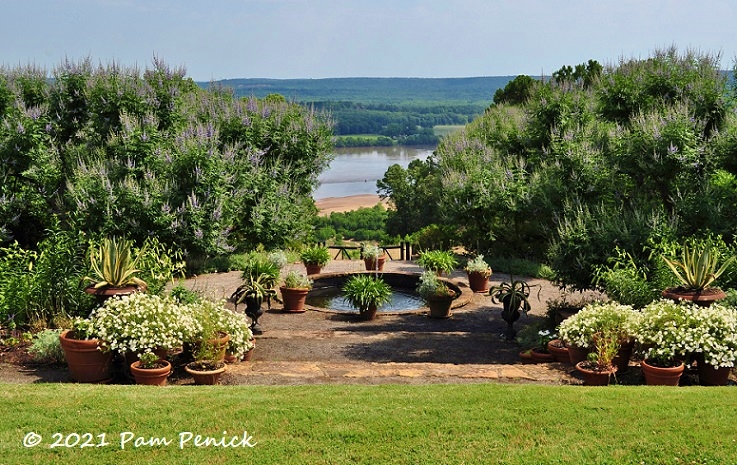
We scooted around the side of the house to reach the Terrace Garden, and there was plenty to see along the way, but first the grand view. From a terraced lawn behind the house, and from the home’s two-story porches, you look across a circular pond framed by four vitex trees to the broad, muddy Arkansas River and green hills beyond. It’s a stunning vista.
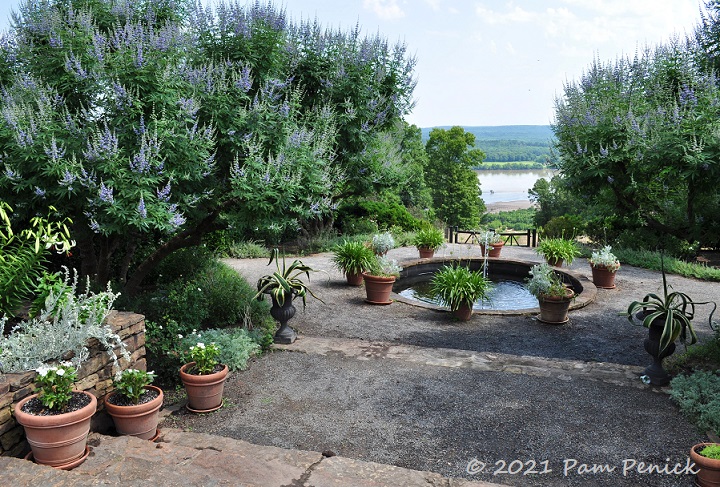
The vitex trees were in full flower, their purple bloom spikes bristling atop palmate leaves and gnarled trunks like olive trees. They made me want to replant another, despite how much pruning they require to maintain their multi-trunked form.
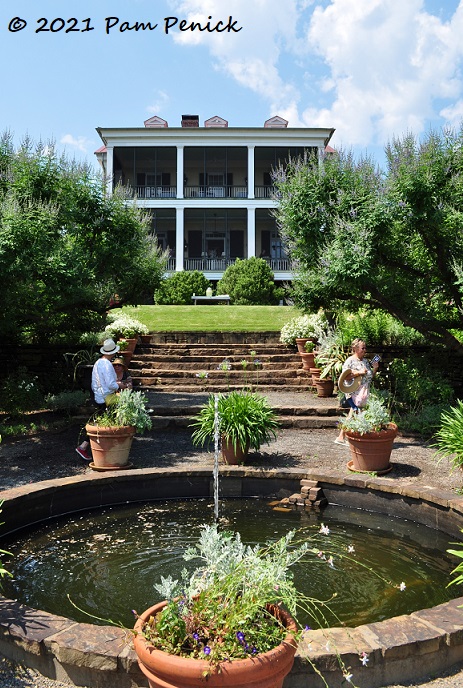
Agapanthus and other terracotta-potted plants ring the pond and line the broad stone stairs leading up to the house. I bet those stacked bricks in the pond are a ladder for wildlife to safely get in and out for a drink.
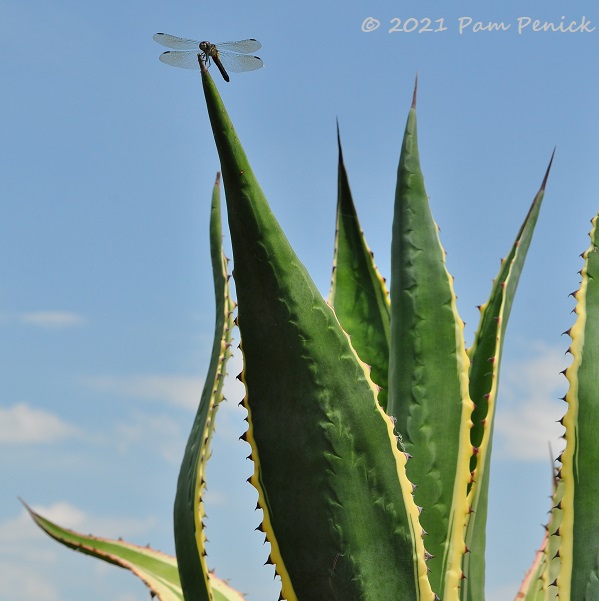
Agaves in Arkansas? Yes, indeed! Smith said he loves to plant variegated American agave in pots for its architectural form, and in his climate he never needs to water them, although he does bring them indoors in winter.
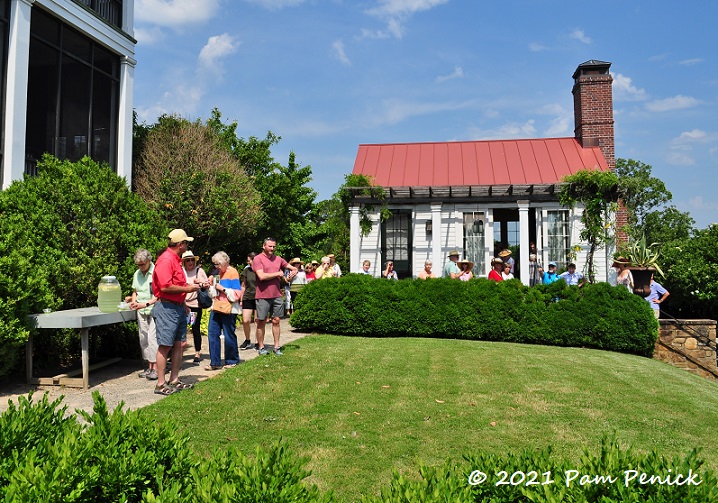
Two outbuildings, white with red metal roofs like the main house, bookend the terraced lawn. This structure is Smith’s art studio. His original watercolors and prints of fruits and landscapes were available for purchase in the gift shop.
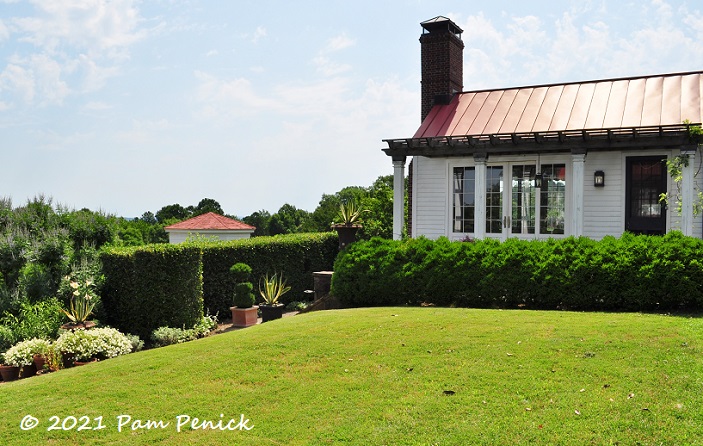
Opposite stands a summer kitchen, with a pizza oven and patio seating on the terrace below.
Terrace Garden
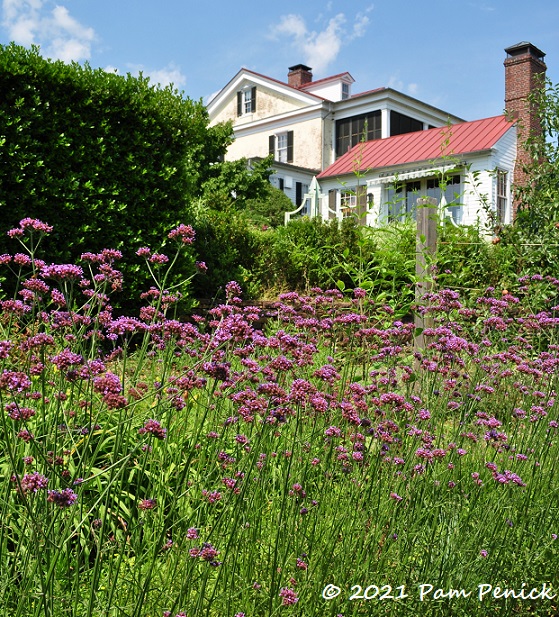
The Terrace Garden stretches out on each side of the house along a mown lawn path, with perennial borders and espaliered fruit trees and vine-draped tuteurs and grape arbors and…OK, so there was a lot to see. Here’s a swath of airy Verbena bonariensis and a view uphill back to the house.
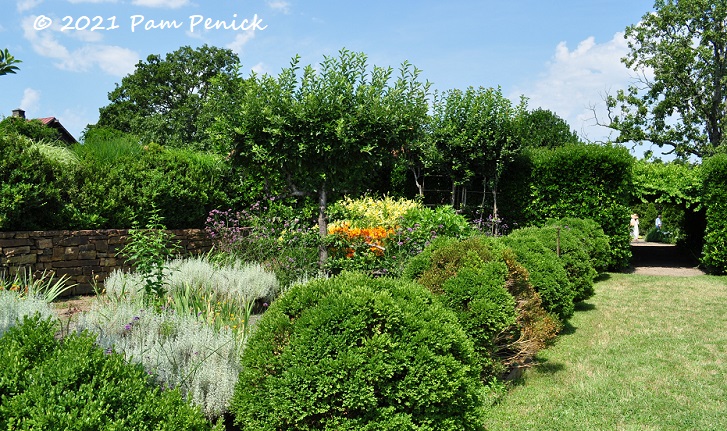
Boxwoods edge this part of the border like giant green gumdrops.
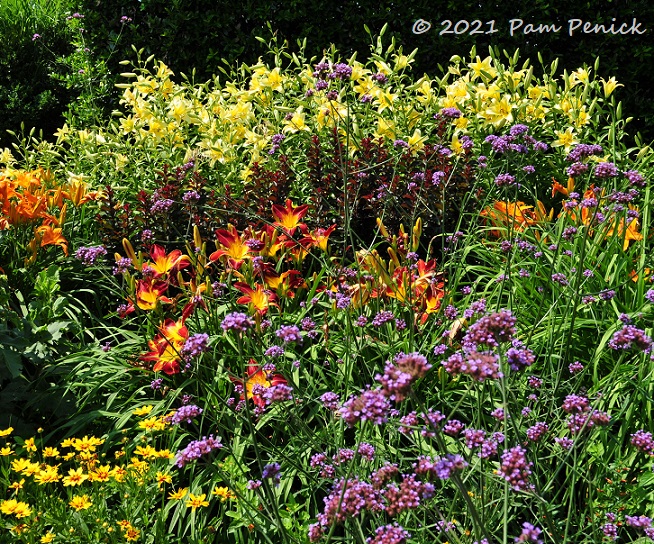
A blazing display of daylilies, Asiatic lilies, and verbena caught my eye. I don’t know what the burgundy foliage is in the middle. Any guesses?
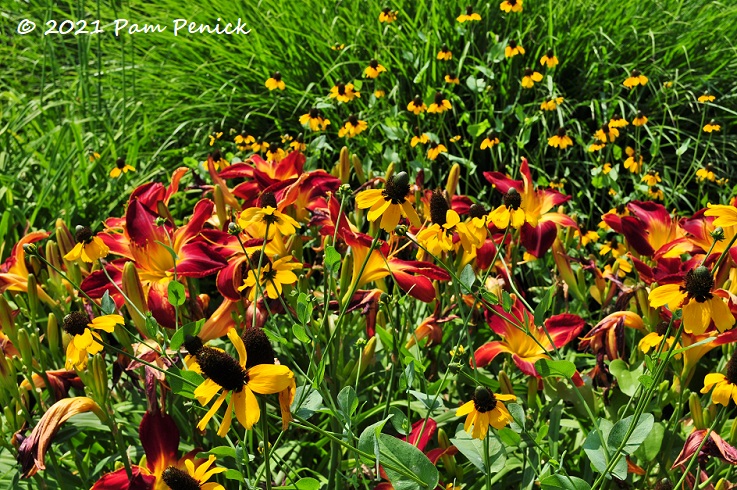
Coneflowers and daylilies soaking up the sun
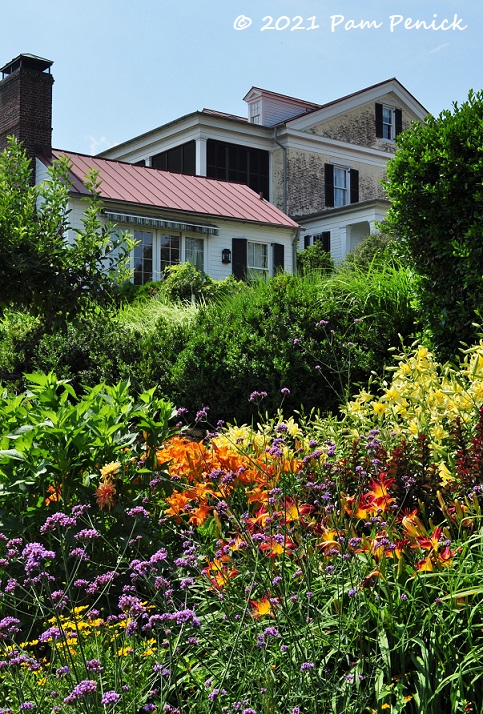
Another view
Drying houses
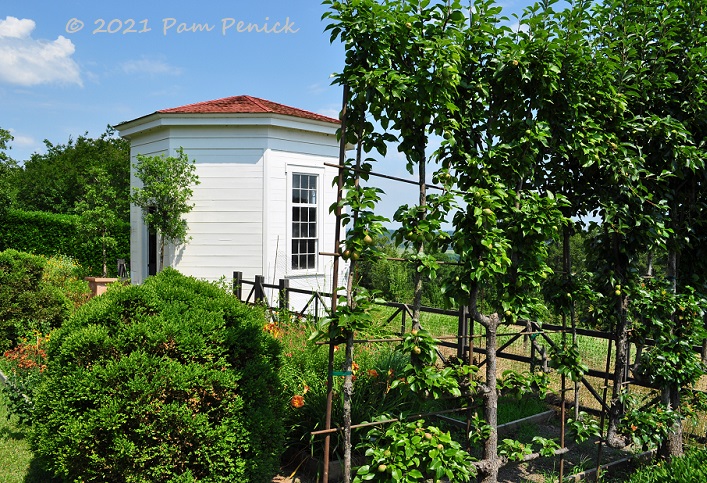
In keeping with the style of an 1840s house and influenced by Thomas Jefferson’s Monticello, Smith added two symmetrical drying houses near each end of the garden.
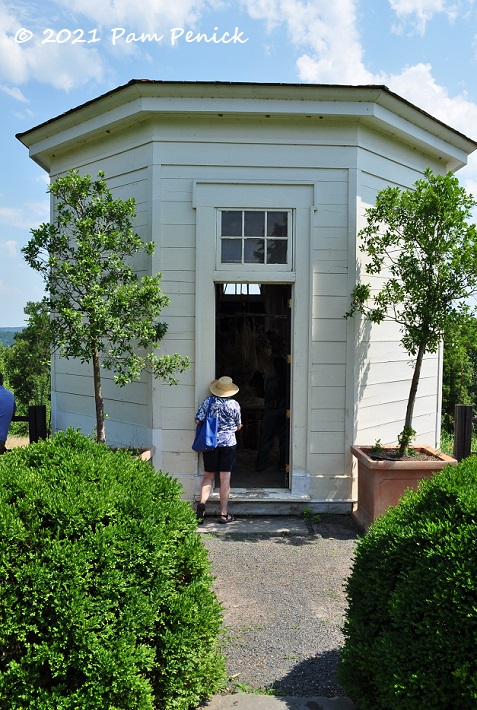
Inside, bunches of herbs and flowers are hung to dry. I wish I’d gotten a photo, but you can see one in this blogger’s post (along with many other terrific images).
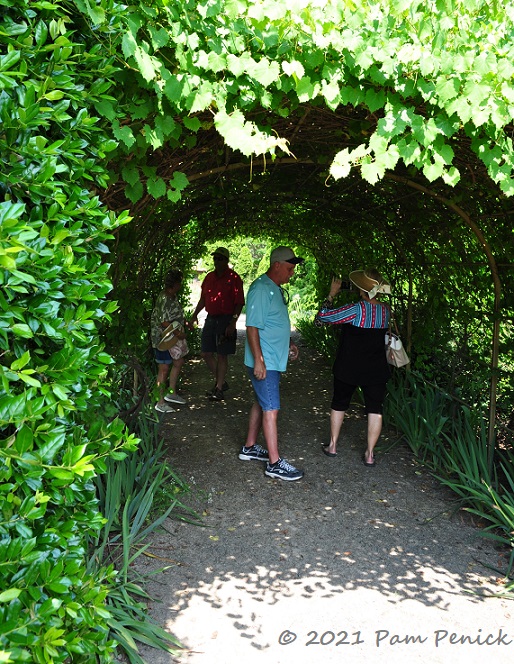
The grapevine tunnel made for a shady respite on this hot day.
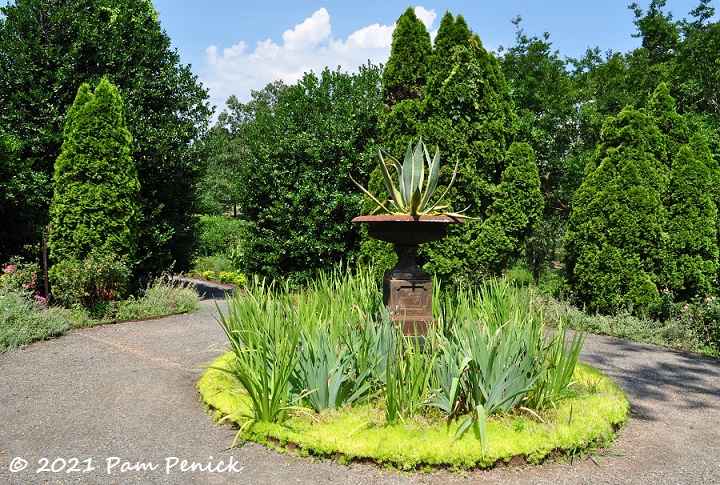
At one end of the Terrace Garden, which I somehow didn’t photograph, a large fig (“Miss Big Fig”) anchors a circular bed. At the other end stands this Victorian-style urn with a yellow-striped American agave, surrounded by iris, lemon-lime ‘Angelina’ sedum, and arborvitae.
Side gardens
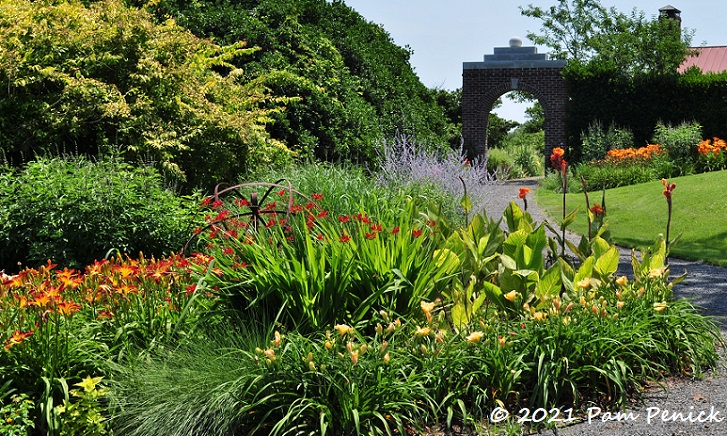
Heading back around to the front of the house, I admired this lovely planting of crocosmia, daylilies, canna, and Russian sage.
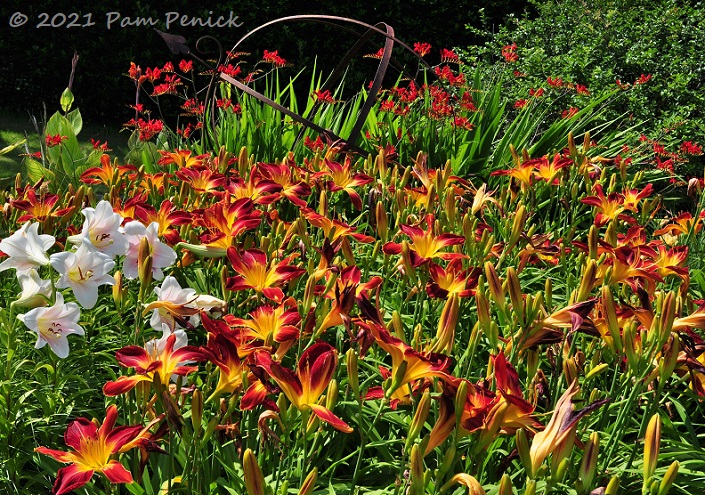
Glorious hot color, with a little splash of blushing white for contrast
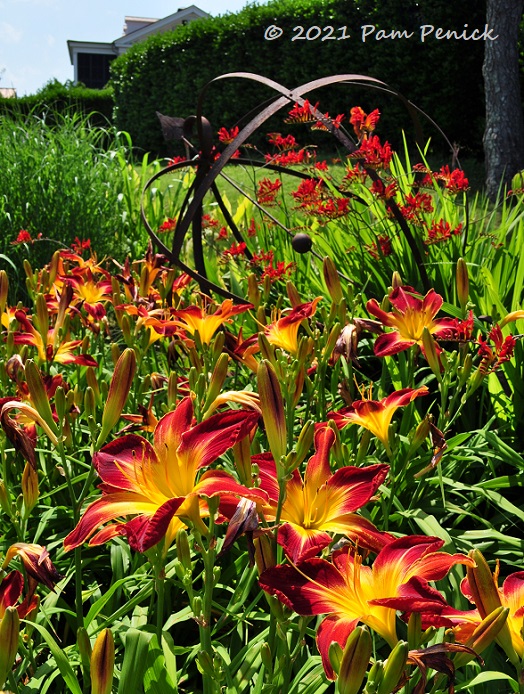
One more of the crocosmia and velvety red-and-yellow daylilies
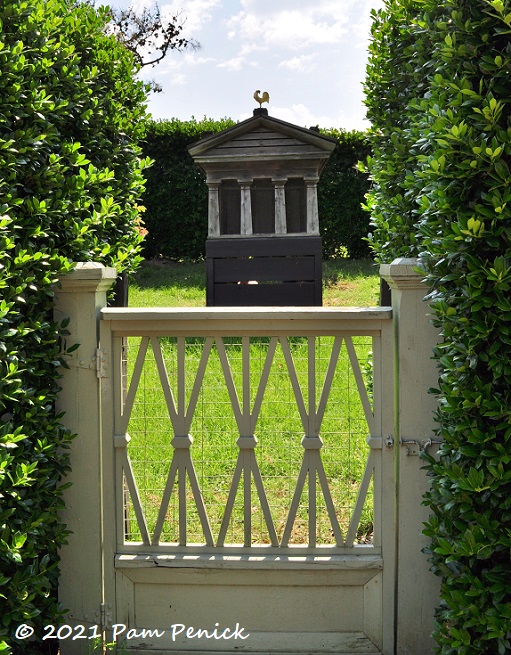
A wooden gate in a tall hedge reveals the Bantam Temple, a stylish coop for a few chickens I saw in here. Smith has an entire barn called Poultryville dedicated to his obsession with heirloom poultry, which Mom and I skipped because it was a long walk on a hot afternoon at the end of the tour. But you can see it here. (Transport would be welcome for those with mobility challenges, but that’s not offered. If you go, be prepared for up to 2 miles of walking on hilly terrain.)
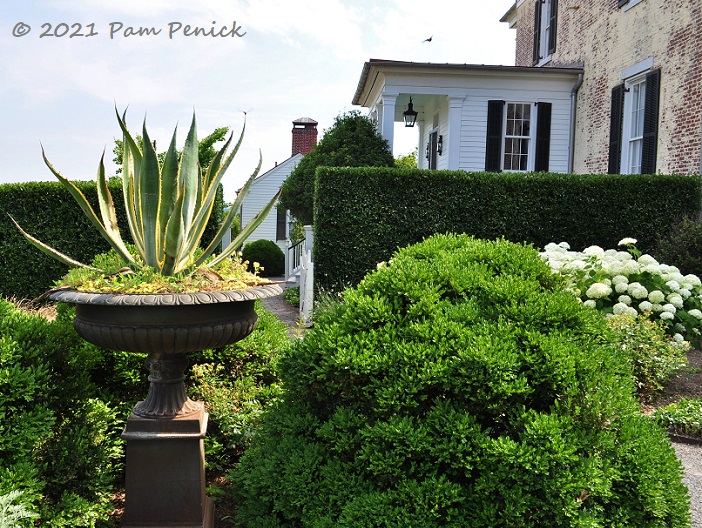
Another agave along the side-garden path. Loree (“there’s always an agave”) Bohl would be pleased!
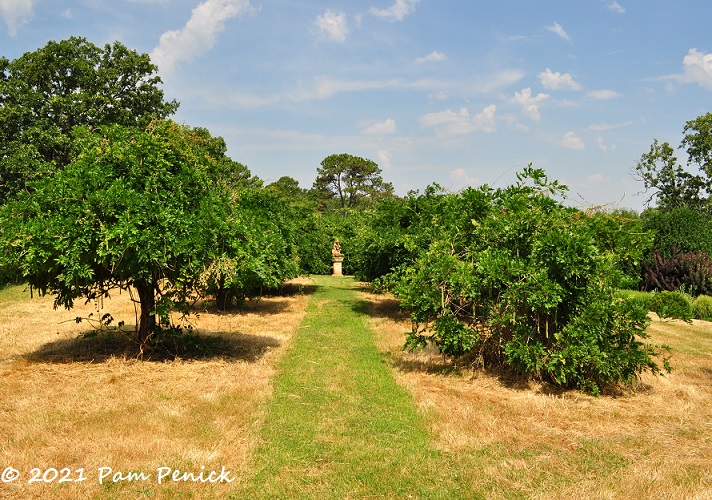
An allée of wisteria trees in a golden meadow, with a mown path to a focal-point statue, provides another romantic moment in the side garden.
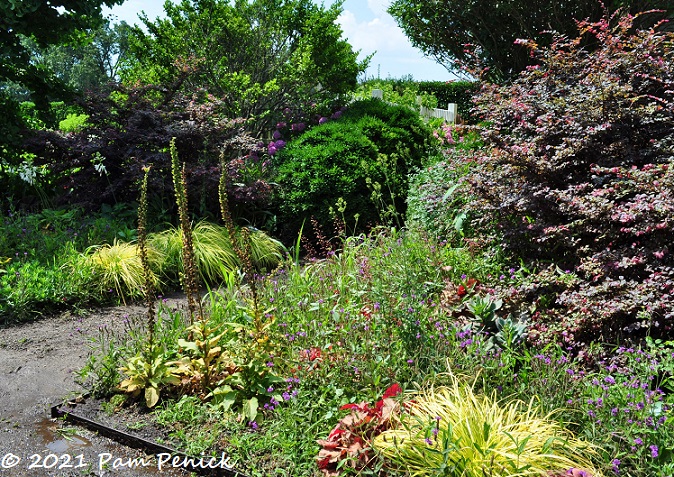
I didn’t explore this muddy path (there had been recent rain), but I admired the mix of wine-red foliage, purple flowers, and golden sedges.
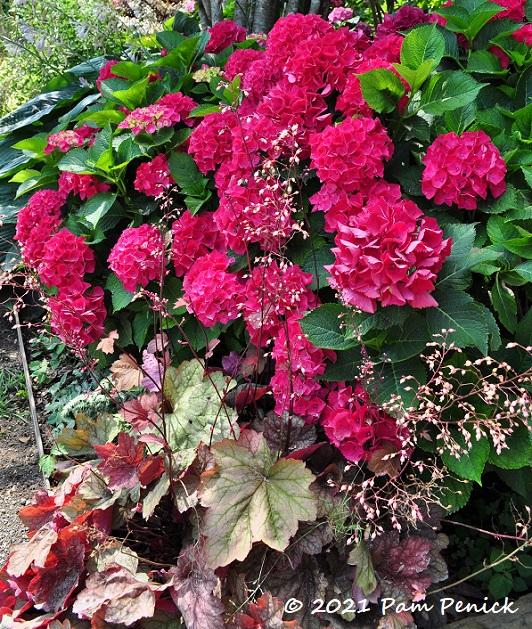
Heuchera and hydrangea share a nice color echo.
Tuteurs and Rose of Sharon
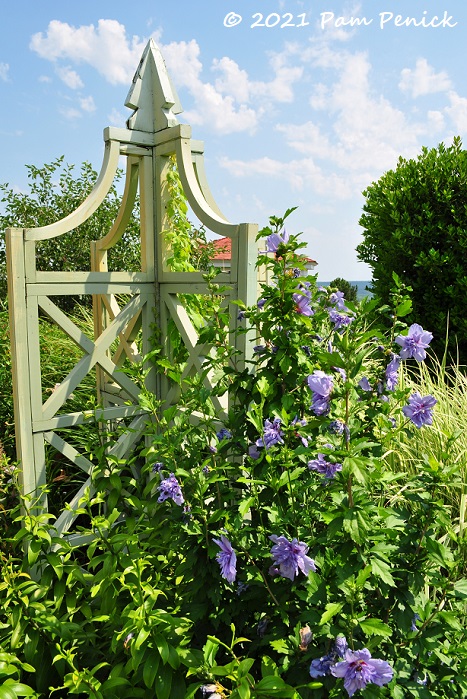
I’ll end Part 1 of my tour with this scene from the Terrace Garden: purple rose of Sharon and a celery-green tuteur. I asked two guides for the cultivar name, and they didn’t know it, but they said it’s commonplace in Arkansas.
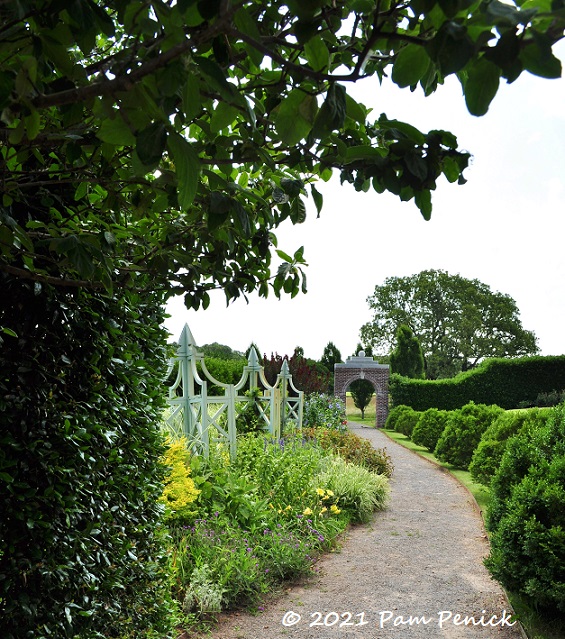
As we learned from Smith at lunch, the gardens are maintained organically, and pollinator and bird species have increased tremendously with the addition of the flower gardens, hedges, grasses, and water features. Smith believes in shrinking the lawn and letting weeds like clover grow in it, not dousing plants with chemicals, collecting rainwater for irrigation, and using green-energy sources like solar. He’s on a mission to teach others about living more lightly on the earth, and the tours are part of that.
Up next: Part 2 of my tour of Moss Mountain Farm, including the house, vegetable garden, hidden rose garden, and P. Allen Smith at lunch.
__________________________
Digging Deeper
Subscribe to Digging and get updates delivered directly to your inbox. It’s easy! Just click over to follow.it (my subscription service), enter your email, and click Follow. An email confirmation will be sent, and click on that to confirm. You’re done! A head’s up: if you’re a longtime subscriber, I’ve had to switch services, and my updates now come from follow.it. You may find they’re going into your spam folder (ugh, sorry!). If so, add follow.it to your trusted contacts to keep receiving Digging. Thank you for reading!
Come learn about gardening and design at Garden Spark! I organize in-person talks by inspiring designers, landscape architects, authors, and gardeners a few times a year in Austin. These are limited-attendance events that sell out quickly, so join the Garden Spark email list to be notified in advance; simply click this link and ask to be added. Season 8 kicks off in fall 2024. Stay tuned for more info!
All material © 2025 by Pam Penick for Digging. Unauthorized reproduction prohibited.


Good thing you stopped and took the tour. Gorgeous garden especially those huge elegant oaks. I know the name of PAS but always thought he was based out of California. Nice to see beautiful gardens from states lesser known for their gardens. Look forward to part 2
Thanks, Elaine. I always look for gardens to visit along the way on a road trip. When I realized that PAS’s garden was on our route and we could fit in a tour, I couldn’t resist getting tickets. It was a pricey outing, but an enjoyable one. I’m glad I saw it.
I used to watch his show and really enjoyed it. I think the comparison to Martha is spot on based on size and detail and fully thought out concepts. Really stunning even if it’s not one’s own type of garden.
Yes, it is. And there’s much more to come in Part 2 of the tour.
Yes I was! (pleased) He does agaves well. I remember those blogger events… and wondering what I would do if asked to attend, of course I didn’t have to worry about it as I was never asked…
I’m glad we have the Fling, which is open to all bloggers!
What a beautiful and varied place. It definitely looks like a great garden tour. It’s interesting to read your insights about the farm and the man.
It was a well-run tour of a lovely garden and home. I enjoyed it.
I loved this. Thank you so much for sharing this wonderful tour!
My pleasure, Lee!
Impressive mix of beautiful vignettes. The dark leafed bush you asked about in the hot border is, from what I can see, a dark-leafed crepe myrtle.
Thanks for the possible ID, Robert!
Hi Pam,
Just read your July blog post on a visit to Moss Mountain. I enjoyed it very much. Found this link from P. Allen’s email newsletter from yesterday. My sister and I visited Moss Mountain 5 years ago, and we thoroughly enjoyed it! So all your photos were memories for us. Thank you for the walk down Memory Lane. I will have to check out some of your other posts.
Welcome, Deb, and thanks for letting me know about the link to my post in P. Allen’s latest newsletter!
Hi Pam,
As a retired florist with a degree in Horticulture, my Husband and I were thinking of a trip to the Farm last year but due to the pandemic, we decided not to go. Thanks for your pics of the tour. I also use to watch P. Allen on tv and loved watching him. I now think we will try to make it to the farm next year.
Judy from Co.
I hope you get to go and enjoy it as I did, Judy. It’s a beautiful place.